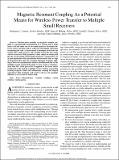Magnetic Resonant Coupling As a Potential Means for Wireless Power Transfer to Multiple Small Receivers
Author(s)
Cannon, Benjamin Louis; Hoburg, James F.; Stancil, Daniel D.; Goldstein, Seth Copen
DownloadCannon_Magnetic-Resonant-Coupling.pdf (453.1Kb)
PUBLISHER_POLICY
Publisher Policy
Article is made available in accordance with the publisher's policy and may be subject to US copyright law. Please refer to the publisher's site for terms of use.
Terms of use
Metadata
Show full item recordAbstract
Wireless power transfer via magnetic resonant coupling is experimentally demonstrated in a system with a large source coil and either one or two small receivers. Resonance between source and load coils is achieved with lumped capacitors terminating the coils. A circuit model is developed to describe the system with a single receiver, and extended to describe the system with two receivers. With parameter values chosen to obtain good fits, the circuit models yield transfer frequency responses that are in good agreement with experimental measurements over a range of frequencies that span the resonance. Resonant frequency splitting is observed experimentally and described theoretically for the multiple receiver system. In the single receiver system at resonance, more than 50% of the power that is supplied by the actual source is delivered to the load. In a multiple receiver system, a means for tracking frequency shifts and continuously retuning the lumped capacitances that terminate each receiver coil so as to maximize efficiency is a key issue for future work.
Date issued
2009-07Department
Massachusetts Institute of Technology. Department of Electrical Engineering and Computer ScienceJournal
IEEE Transactions on Power Electronics
Publisher
Institute of Electrical and Electronics Engineers
Citation
Cannon, B.L. et al. “Magnetic Resonant Coupling As a Potential Means for Wireless Power Transfer to Multiple Small Receivers.” Power Electronics, IEEE Transactions on 24.7 (2009): 1819-1825. © 2009 Institute of Electrical and Electronics Engineers
Version: Final published version
ISSN
0885-8993